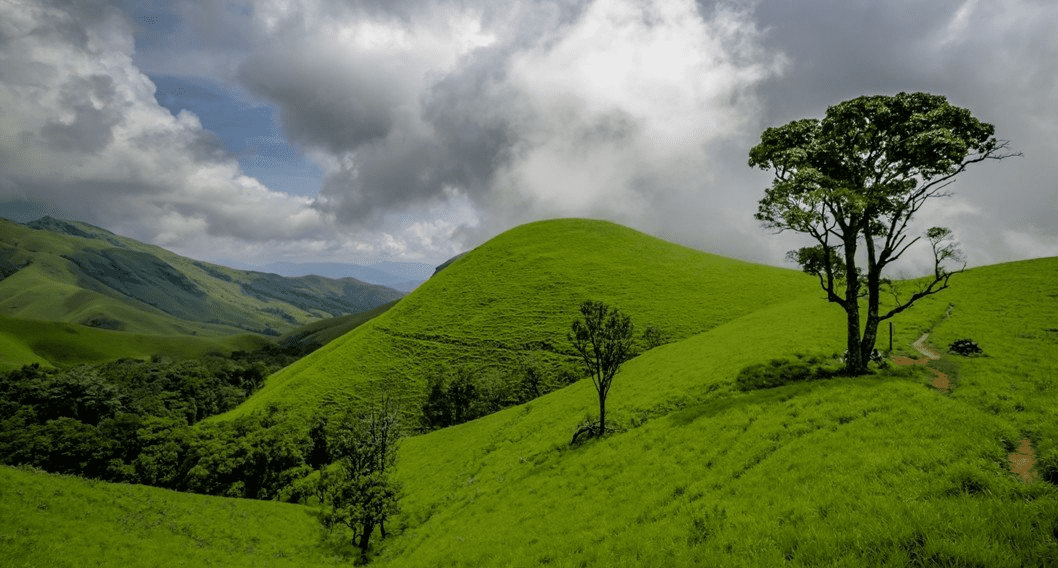All About Kudremukh Trek

Kudremukh is known as Samseparvath historically and horse’s face in Kannada. The horse’s face name is because of the distinctive shape of the peak. Kudremukh is nestled in the western ghats in Chikkamagaluru district, Karnataka. Kudremukh trek comes under Kudremukh National Park which is the second largest wildlife protected area in the western ghats.
Kudremukh is situated at an altitude of 6,207 feet[1] and is the 3rd highest peak of Karnataka after Mullayyangiri and Baba Budangiri.
Best Time to do Kudremukh Trek
The best season to do Kudremukh trek is from June to February. The Kalasa region receives pleasant weather throughout the year.
During monsoon and winter, you can see many small streams, dark shola forest, bamboo shrubs tall enough to touch the sky and rolling green hills.
Some of the sections of the trek involve trekking under the open sky. Hence, trekking in the summer is not recommended.
How to Reach?
The Kudremukh trek starts from Mullodi village which is around 15 km from Kalasa. Kudremukh Entrance which is about 10 km from Kalasa, where you have to take permission and begin your trek.
One can reach Kalasa by own vehicle or using public transportation and from there to Kudremukh Entrance point.
By road
The base village Kalasa is easily accessible by public transport. There are many buses from Bangalore to Horanadu via Kalasa . Once you get down at Kudremukh entrance point, there is another 5 km walk from the entrance.
By Railway
Nearest railway station for Kudremukh entrance is Mangalore.
Kudremukh is a home for many flora and fauna. You can even explore and spot animals like deer and peacocks on the way while trekking.
Kudremukh is a beautiful trek across misty valleys. You traverse through grasslands, forest and many small streams.
The Kudremukh peak has a unique structure that looks like a horse’s face from the side. This structure is visible only after covering a particular trekking.
You will get through shola towards Kudremukh peak.
Shola is a local name for grassland and shrublands that are visible in the western ghats. Shola forest is home to many wildlife animals like deer, lion tailed macaque, Malabar giant squirrel, leopard, common langur and many more. If you are lucky you can even spot them while trekking. During monsoon season, you can find leeches with every step of trekking on this route.
One of the fascinating parts of this trekking route is the waterfalls and small streams. You have to cross many streams on the way towards the peak.
When you come out of the shola forest, you see a spectacular view of the rolling hills around you. Green hills and misty valleys are the rewards to the eyes. During monsoon, this area might be covered with mist completely. But the hide and seek of the valley in between those clouds and mist is something you should witness.
Kudremukh Trek can be divided into 3 sections.
- The trail from Forest office to Ontimar 2(lone tree)
The trek starts from the forest office. You can hear the sound of the water falling at Somawathi falls and it stays with you for a distance before you get on to the forest trail.
Once you enter the Shola forest notice the thickening of the vegetation. You can spot wildlife here if you are lucky enough. This forest is home to many leeches and earthworms.
- Trek from Ontimara 2 to Final stretch.
The trek from the second Ontimara has a combination of trekking through a gentle slope and also a steep ascent as you approach the last leg of your trek. This section is very scenic and you get to see the beautiful rolling green hills. This is the most beautiful part of the trek! The peak is right in front of your eyes and the excitement begins about reaching the summit.
- The ridge walk from the final section to the peak
You are at the top of the Kudremukh now. To see the best view of the peak you need to go a little down to the ledge. Make some space to sit. Kudremukh peak can get very windy
Things to carry!
- Basic First Aid kit
- Identity Card
- Cap/ Scarf/ Bandana & Sunglasses
- Water (Minimum two litres)
- Lemon and salt OR Electrolyte Powder/Drink (Electral/Gatorade/Glucon D, etc.)
- Quick Dry Full Sleeve T-shirts are preferable over cotton tees.
- Plastic sheet to wrap electronic devices, only during monsoons
- Sunscreen (SPF 50+)
- Scissor
- Band-aids
- Analgesic spray (Relispray, Volini, etc.)
- Antiseptic Liquid (Savlon, Dettol etc.)
- Cotton roll & Bandage
- Tablet for motion sickness (Avomine), Acidity (Gelusil, Digene, etc.).
- Mild pain relief tablet (Crocin)




